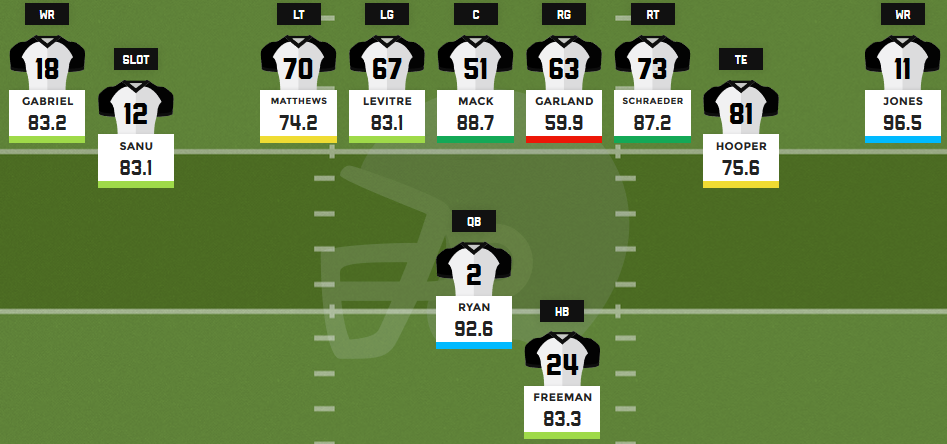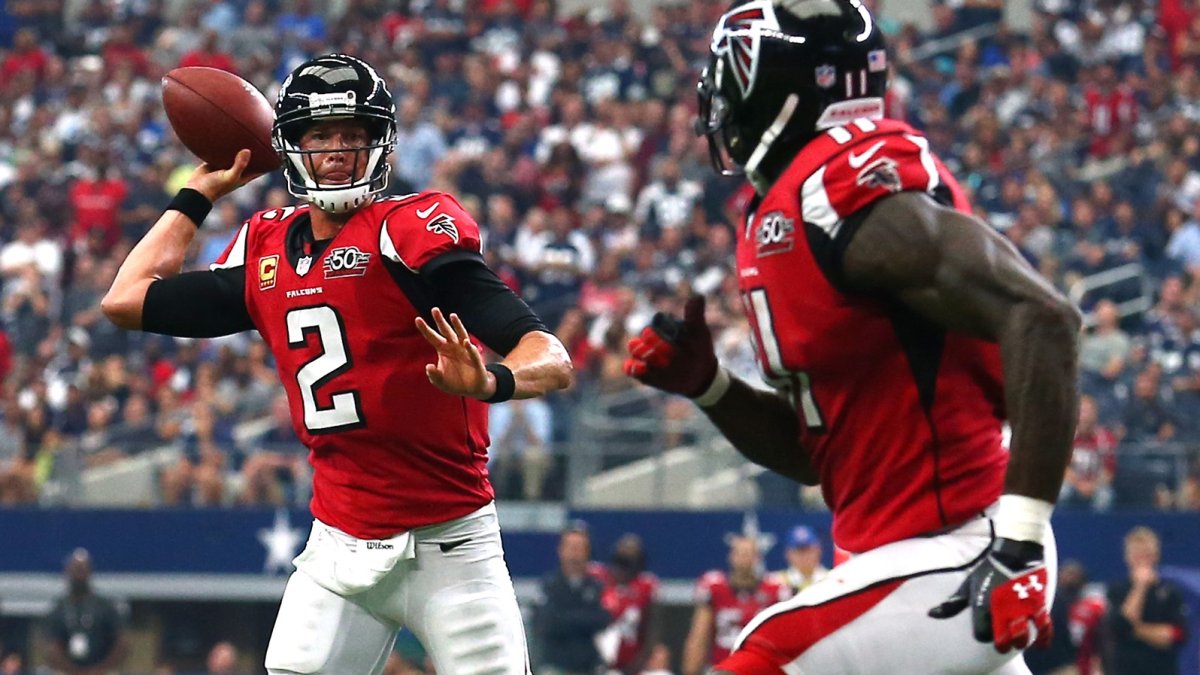The 2016 Falcons may be remembered as the team that let the Super Bowl slip away, but they were also one of the most potent offenses we’ve seen in recent memory. Atlanta was the only team in the league to rank in the top five in both rushing and passing yards per game. They also paced the league with an average of 33.8 points per game. Of course, we may be burying the lead a little bit here, as a lot of the credit for Atlanta’s offensive prowess has to go to former offensive coordinator Kyle Shanahan. With Shanahan now in San Francisco, Steve Sarkisian will take the reins. The longtime college coach only has one year of NFL coaching experience – he was the quarterbacks coach in Oakland back in 2004. Though we don’t know exactly what his offense will look like, the expectation is that Sarkisian’s offense will not be a major departure from what Shanahan ran.
|
Team Offensive Stats |
|||
| ATL | Rank | Lg Avg | |
| Snaps/Gm | 63.4 | 25 | 65.3 |
| Pace (Sec/Sn) | 25.46 | 29 | 24.28 |
| Run % | 41.5% | 10 | 39.8% |
| Pass % | 58.5% | 23 | 60.2% |
| % Leading | 53.5% | 2 | 36.0% |

Quarterback
At this time last year, you could have gotten Matt Ryan for nothing in drafts. His ADP had him as undrafted, and he went on to finish second in scoring thanks to a career-high 38 touchdown passes. Perhaps the writing was on the wall for this breakout and we should have payed closer attention to Ryan’s yardage productivity from the previous four seasons. Ryan had at least 4,500 yards passing in each of those seasons. But still, 2016 was a big leap forward for Ryan. His yards per attempt jumped from 7.90 in 2015 to 9.26 in 2016. He also completed over 70 percent of his passes for the first time in his career. While we may see some touchdown regression, Ryan is still locked in as a strong QB1 option.
|
Vacated Touches |
||
| 2016 Touches | % Vacated | |
| Carries | 384 | 0.8% |
| Targets | 505 | 14.1% |
| Total | 889 | 8.3% |
Running backs
There was a time not too long ago where committee backfields were the scourge of fantasy football. Those days look to be moving into the rearview, as teams like the Falcons have shown that running backs can maintain a high level of fantasy production despite being in a committee. Devonta Freeman followed up his No. 1 fantasy finish in 2015 with another RB1 year last season, ranking sixth at the position in fantasy scoring. And he did so while splitting time with Tevin Coleman. Of course, he was on the better side of the committee, seeing 54.3 percent of the Falcons rushing attempts and 12.1 percent of the targets. But Freeman’s 17.6 touches per game was far from the league leaders. At the same time, he was very efficient with his touches, and more importantly, he led the team with 19 carries inside the 5-yard line. Tevin Coleman saw just four. Freeman remains a strong RB1 in 2017.
Despite being on the short end of the committee, Coleman is oozing with upside and has instant RB1 potential if Freeman went down. Last year, he posted an impressive 2.76 yards after contact per attempt and scored a massive eight times on just 116 carries. He also took a step forward as a receiver, posting 31 catches on 37 targets. Coleman nearly equaled Freeman’s receiving yards despite having 23 fewer catches. Consider Coleman a handcuff-plus this year since you can potentially toss him in your flex spot.
|
Rushing Stats |
|||
| ATL | Rank | Lg Avg | |
| YPC | 4.58 | 5 | 4.18 |
| YCo/Att | 2.25 | 25 | 2.43 |
| YBCo/Att | 2.33 | 3 | 1.76 |
| Inside Zone | 30.6% | 8 | 26.0% |
| Outside Zone | 39.9% | 8 | 27.7% |
| Power | 8.1% | 24 | 9.5% |
| Man | 5.7% | 21 | 15.0% |
Wide receivers
One of the league’s best receivers, Julio Jones has 100-plus yards in 35 of 79 games played (44.3 percent). That massive level of productivity has propelled him to top-six fantasy finishes in each of the last three seasons. While Jones sees heavy target volume – he’s been targeted on over 25 percent of his routes each season since 2013 – the Falcons did not heavily involve him in the red zone last year. Jones saw 16 red-zone targets, which is dramatically down from the 32 targets he saw in 2015. When we look at end-zone targets, Jones had six, which was actually one more than he saw in 2015. Still, that number is far off Mike Evans’ league-leading 21 end-zone targets. However, the Falcons have said that they’re making it a point of emphasis to get Jones the ball in the red zone. Regardless, he remains an elite fantasy option.
There really isn’t much value beyond Jones in this receiver corps. Mohamed Sanu was solid last year, posting 59 catches for 653 yards and four scores. But he has just two top-20 fantasy weeks and finished a lowly 52nd among wide receivers. Taylor Gabriel flashed DFS upside with five top-15 fantasy weeks, but low target volume and weekly volatility make him a less-than-desirable option in season-long leagues.
|
Wide Receiver Sets |
||||||
| % | Rank | Lg Avg | Throw% | Rk | Lg Avg | |
| 2-Wide | 41.1% | 2 | 24.5% | 42.0% | 18 | 45.0% |
| 3-Wide | 39.8% | 30 | 55.5% | 71.3% | 5 | 66.1% |
| 4-Wide | 0.5% | 24 | 2.9% | 100.0% | 1 | 81.6% |
Tight end
The Falcons have one of the more intriguing tight end sleepers in Austin Hooper. A third-round pick in 2016, Hooper caught just 19 balls last season. Despite the lack of volume, he flashed upside at times, including an 84-yard performance in Week 2 and a 42-yard touchdown reception in Week 4. Hooper finished second among Atlanta tight ends in snaps played, but did lead the group in routes run with 220. That number will likely increase this year, as the No. 2 finisher, Jacob Tamme, is no longer on the team. At this point, Hooper is still a bit of an unknown for fantasy purposes. But his upside and good situation make him an intriguing dart to throw in the late rounds.
|
Personnel Groupings |
||||||
| % | Rank | Lg Avg | Throw% | Rk | Lg Avg | |
| 11 | 39.6% | 28 | 53.5% | 71.1% | 4 | 33.5% |
| 12 | 15.6% | 15 | 15.6% | 45.6% | 18 | 50.2% |
| 21 | 25.5% | 1 | 6.9% | 39.8% | 18 | 62.5% |
(Keep up with all of PFF Fantasy’s draft strategy and advice here!)




 © 2025 PFF - all rights reserved.
© 2025 PFF - all rights reserved.